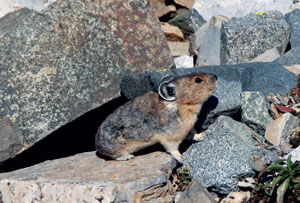Lucas Moyer-Horner crams his arm under a truck-sized boulder and pulls out a handful of peppercorn-like pellets. The dark brown scat belongs to a small animal that looks like a fur-covered Russet potato. American pikas inhabit high alpine talus slopes – rugged, steep places most people fear to tread, but Moyer-Horner scampers over like he’s in a playground. “Pika get me up high,” he says. “Grizzlies or elk wouldn’t.”
The University of Wisconsin-Madison zoologist has spent his summer hiking more than 500 miles of Glacier National Park to search for pika. He climbed peaks to spot their likely talus habitats and then surveyed the rubble of rock for signs of the rabbit-cousin – all to gain a baseline on the park’s population. Since heat intolerant pikas have been disappearing from the West, Glacier Park wants a starting point to chronicle the future of the endearing creature.
In August, conservation groups filed a lawsuit in the U.S. District Court in California seeking protection of the pika under the Endangered Species Act. Its thick insulation, furry feet, high metabolism and small ears retain heat, permitting the pika to live under mounds of snow all winter without hibernating, but those same features also make heat its enemy. “They are poor heat dissipaters,” explains Moyer-Horner. Over the past 50 years, pika populations have been dying off from the Great Basin and Sierra Nevadas, with the lowest elevation sites seeing the most extirpation. Scientists fear more may disappear as global temperatures rise.
Moyer-Horner, too, is wondering how climate change will affect pikas as they can’t climb much higher to escape heat. With his study supported by the Glacier National Park Fund, he’s one of about a half-dozen pika researchers across the U.S. tromping with ears tuned to its high-pitched “eeep.”
In Lunch Creek basin east of Logan Pass, Moyer-Horner takes a GPS reading at a broad swath of furniture-sized boulders before picking his way up the slope. He stops every few feet to poke his head under a rock ledge. Some are bare; a few contain scat and hay piles.
 |
|
Pika are small 6- to 8-inch cousins of rabbits that live in talus slopes at high elevation. This one is from Lunch Creek just east of Logan Pass. |
Similar to rabbits, pika eat their own scat to glean more nutrients. Their peppercorn-like scat, the result of the second feast, litters their pathways to the world below boulders, where temperatures stay cooler in summer and warmer in winter. Dropping a few pellets in an envelope, Moyer-Horner intends to use the feces to check hormone levels, possible indicators of stress due to global warming.
Starting in mid-August, pikas begin a frenetic race during daylight to gather hay –flowers, grasses, fir clippings, and leafy plants. Piled under rocks, their hay dries. Some piles can be quite large – up to several feet wide. Pikas then cart the dried hay below into their rocky kingdom for winter food. “They don’t seem to be too picky about what they eat,” says Moyer-Horner, as he bags up a small handful of grasses, meadowrue, and a western anenome seed head. “But a pika needs to fill his belly about nine times per day.”
In addition to scat, hay piles, and telltale screams, Moyer-Horner is looking for the five-ounce furballs themselves. They skitter to a nearby meadow and grab mouthfuls of greenery, sometimes larger than themselves. They run below rocks and suddenly pop up, curious to survey their surroundings. If threatened, they “eeep” a warning to others.
For the pika, climate change is more insidious than an invading short-tail weasel. When exposed even an hour to 80-degree temperatures, pikas may die. Heat may also force them to retreat under their rocks rather than gathering hay, resulting in meager supplies stored in the winter larder. Shrinking snow pack is also of concern, adds Moyer-Horner, as that may lessen the natural blanket protecting them from the elements.
Aided by three paid assistants and a few volunteers, Moyer-Horner seeks to identify all of the park’s talus slopes that may house pikas – a daunting task across one million square acres. He expects to locate two-thirds of the sites by October and survey half of those for signs of pika. His study is also being helped by a bevy of citizen science volunteers trained by Jami Belt, High Country Citizen Science coordinator for the Crown of the Continent Research Learning Center. But funding still needs to gel for the study to continue next summer.
Without any previous population estimates, Moyer-Horner cannot speculate on Glacier’s pika status. But he is discovering that 90 percent of the talus slopes in Glacier harbor the round-eared creatures. He’s found them as high as 9,000 feet and surprisingly below 4,000 feet along McDonald Creek.
This winter, Moyer-Horner hopes to collate his data into a population estimate. From then on, only time and temperature will tell the pika’s fate.